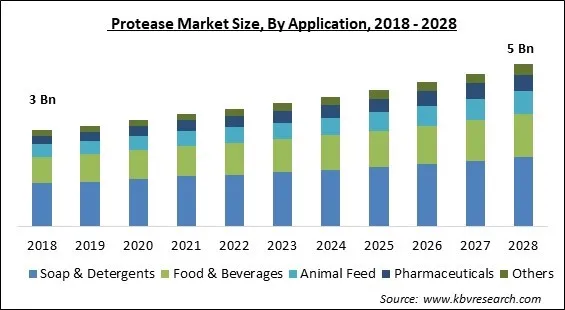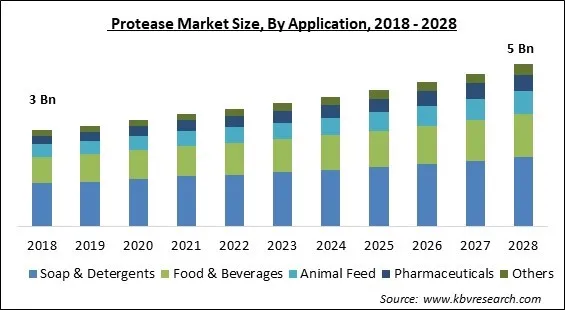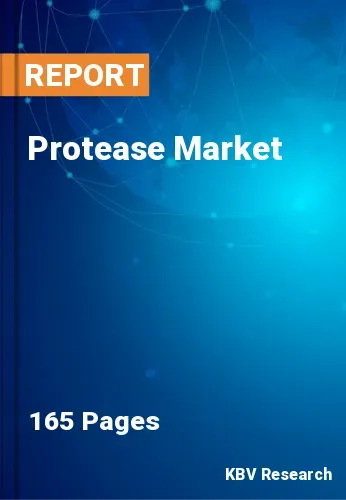The Global Protease Market size is expected to reach $5 billion by 2028, rising at a market growth of 5.5% CAGR during the forecast period.
An enzyme termed a protease, also known as a peptidase or proteinase, catalyzes, proteolysis, which results in the breakdown of proteins into smaller polypeptides or single amino acids and promotes the production of new protein products. They achieve this by using hydrolysis, a mechanism in which water breaks bonds, to cleave the peptide bonds found in proteins.

Protein digestion after ingestion, protein catabolism (the breakdown of aged proteins), and cell signaling are a few of the biological processes that proteases involved. Proteolysis would occur very slowly, requiring hundreds of years if there were no functional accelerants. All living forms and viruses have proteases. Distinct classes of protease can carry out the same reaction by entirely different catalytic processes as a result of their own numerous independent evolutionary cycles.
The hydrolysis of peptide bonds is a typical chemical reaction that is effectively carried out by proteases. There are several proteases that carry out slightly different reactions from the majority of proteolytic enzymes, which break down -peptide bonds between naturally existing amino acids. Thus, a large class of enzymes called DUBs can hydrolyze isopeptide bonds in ubiquitin and ubiquitin-such as protein conjugates; glutamyl hydrolase and glutamate carboxypeptidase target -glutamyl bonds; glutamyl transferase transfer and cleave peptide bonds; and intramolecular autoproteases such as notably, and under some circumstances, proteases are also capable of producing peptide bonds.
The pharmaceutical industry's increasing use of proteases for their therapeutic advantages, like anticancer, antibacterial, and anti-inflammation, is likely to result in a large increase in demand for them over the forecast period, which will favor the market for proteases globally. Drugs for the treatment of chronic pain, cardiovascular illnesses, and digestive issues are made using proteases.
To reduce COVID-19 transmission through food, the World Health Organization (WHO) has published guidelines for ensuring food hygiene and food safety practices. The demand for protease products with clean labels will rise as a result of these developments. The market will grow over the projected period as a result of the worldwide economy's recovery, which will also result in an increase in per capita income and the adoption of healthier lifestyles.
Because of the many advantages proteases offer, like boosting the immune system, preventing inflammatory bowel diseases, and treating burns, and stomach ulcers, the rise of the healthcare sector will have a beneficial impact on the protease market. However, a large component of the protease market is made up of other sectors, like animal feed, where protease is employed to enhance the nutritional or digestive qualities of fodder and preserve the health of animal guts.
Consumer demand for goods with clean labels as well as natural ingredients is rising. The popularity of protease among those who are concerned about their health has increased as people become more conscious of the necessity to live a healthy lifestyle. The prevalence of chronic illnesses and pandemic situations are encouraging people to adopt healthy eating practices in order to protect themselves against a number of deadly ailments.
Proteolytic enzymes are generally regarded as harmless. However, some people may experience negative effects. It's conceivable, especially if someone takes very large quantities, that may develop digestive problems like nausea, diarrhea, and vomiting. Large amounts of fruits rich in proteolytic enzymes could also irritate the stomach, though supplements are much more likely to do so. Symptoms of allergies can also appear.
Based on source, the protease market is segmented into plants, animals, and microbes. The plant segment acquired a substantial revenue share in the protease market in 2021. Papain and bromelain are two examples of the category of proteases that are derived from plants. Also, factors such as climatic, viability, culture, circumstances, and drawn-out extraction procedures have a significant impact on the usage of plants as a source of proteases. Thus, the protease market would grow in this segment over the forecast period.

On the basis of application, the protease market is fragmented into food & beverage, pharmaceuticals, animal feed, soap & detergent and others. The soap & detergent segment held the largest revenue share in the protease market in 2021. Protease's ability to remove stains has made it possible to use it in detergent manufacturing. Consumer awareness of hygiene and cleanliness is predicted to increase, which will increase the demand for soaps and detergents.
| Report Attribute | Details |
|---|---|
| Market size value in 2021 | USD 3.5 Billion |
| Market size forecast in 2028 | USD 5 Billion |
| Base Year | 2021 |
| Historical Period | 2018 to 2020 |
| Forecast Period | 2022 to 2028 |
| Revenue Growth Rate | CAGR of 5.5% from 2022 to 2028 |
| Number of Pages | 165 |
| Number of Tables | 280 |
| Report coverage | Market Trends, Revenue Estimation and Forecast, Segmentation Analysis, Regional and Country Breakdown, Companies Strategic Developments, Company Profiling |
| Segments covered | Service Type, Deployment, Enterprise Size, End-use, Region |
| Country scope | US, Canada, Mexico, Germany, UK, France, Russia, Spain, Italy, China, Japan, India, South Korea, Singapore, Australia, Brazil, Argentina, UAE, Saudi Arabia, South Africa, Nigeria |
| Growth Drivers |
|
| Restraints |
|
Region wise, the protease market is analyzed across the North America, Europe, Asia Pacific and LAMEA. The North America region led the protease market with maximum revenue share in 2021. The rising demand for both plant- and animal-based proteases is responsible for the expansion of the regional protease market. The demand for protease is further derived from a variety of food functionalities, the growing importance of washing goods, the rising need for infant formula, and expanding consumption as well as production of meat products.
Free Valuable Insights: Global Protease Market size to reach USD 5 Billion by 2028
The market research report covers the analysis of key stake holders of the market. Key companies profiled in the report include Advanced Enzyme Technologies Limited, Amano Enzyme, Inc., Associated British Foods PLC, BASF SE, Dupont De Nemours, Inc., Koninklijke DSM N.V., Novozymes A/S, Chr. Hansen Holding A/S, Biocatalysts Limited (Brain AG), and Dyadic International, Inc.
By Application
By Source
By Geography


The global Protease Market size is expected to reach $5 billion by 2028.
Increasing Drug And Therapeutic Applications are driving the market in coming years, however, Risks And Possible Side Effects Of Protease restraints the growth of the market.
Advanced Enzyme Technologies Limited, Amano Enzyme, Inc., Associated British Foods PLC, BASF SE, Dupont De Nemours, Inc., Koninklijke DSM N.V., Novozymes A/S, Chr. Hansen Holding A/S, Biocatalysts Limited (Brain AG), and Dyadic International, Inc.
The Microbes segment acquired maximum revenue share in the Global Protease Market by Source in 2021 thereby, achieving a market value of $3.0 billion by 2028.
The North America market dominated the Global Protease Market by Region in 2021, and would continue to be a dominant market till 2028; thereby, achieving a market value of $1.7 billion by 2028.
Our team of dedicated experts can provide you with attractive expansion opportunities for your business.

